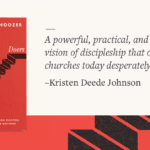
Sola Scriptura is not simply a doctrine about the relationship of Scripture and tradition. It is also a rule that applies to the Christian imagination: Scripture alone is the ultimate story from which disciples must take their existential bearings. Scripture alone provides the metaphors, images, and narratives that are the authoritative guides for both thinking about and doing life together as Christ’s church. Scripture alone defines the kind of wellness, health, and fitness that disciples should be striving for.
As with any other form of exercise, what I propose here needs to be practiced on a regular basis in order to reap the benefit. A person cannot become physically fit by climbing a flight of stairs one time only. Similarly, pastors cannot change a social imaginary with a single sermon. Keep in mind that the ministry of the word extends beyond preaching. Spiritual formation happens whenever words are ministered: in counseling sessions, Sunday school classes, prayers, pastoral visitations, even everyday conversation. Paul encourages his readers to perform something very much like what I am calling a core exercise when he asks them to remind each other that the story in whose light they live ends with Jesus’ triumphant return: “Therefore encourage one another with these words” (1 Thess 4:18). Similarly, each of the core exercises is a way of helping one another to inhabit the new reality in Christ—what Karl Barth called “the strange new world of the Bible”—indicated by Christian doctrine.
Exercise 1: Read Scripture to Correct Our Pictures of Church Leadership
How would you describe the kind of leader people follow today? What images of leadership hold sway in contemporary culture? To what extent have cultural pictures of leaders infiltrated the church—in particular, our thinking about pastors? The Bible provides corrective lenses that allow us to align the eyes of our heart with the way God wants us to see things. It is vital that church elder boards and congregations become aware of the influence of secular pictures of leadership on their thinking about pastors.
Encourage your elders and congregation to think biblically about leadership. For example, think about the leaders God gave Israel and the church: How are pastors like prophets, priests, and kings? Think in particular of the role the word of God played in each of these offices. Think of leaders in the early church and how they decided to devote themselves to the ministry of the word (Acts 6:1–6). Use Scripture to reform your church’s notions of what church leadership should look like. Hopefully your congregants will come to appreciate the pastor not only as a preacher, program manager, and people helper but also as a theologian: one who casts biblical visions of new life in Christ, individual and corporate. These are the pictures pastors can lead by and local churches can live by.
Exercise 2: Read Scripture to Open Your Congregation’s Eyes to the Way in Which a Culture’s Social Imaginary Is a Means of Spiritual Formation
Pastors cannot know everything about everything, but they should be able to know one big thing about everything: whether or not it fosters life in Christ. Pastors need to practice reading the signs of the times, and that means learning to read cultural texts and cultural trends. By culture I mean everything in our world that is man-made, especially the things that embody and give visible expression to the meaning of life.
Whether we are aware of it or not, everyone who is part of culture receives cultural messages, some of which are explicit but most of which are implicit—messages that work their way into our subconscious, there to construct a plausibility structure, brick by brick. Pastors do disciples a great service by opening their eyes to the social imaginaries that so often hold us in their grip. Use Scripture to expose the idols and ideologies of our time, perhaps by preaching on the forms contemporary idolatry takes.
Exercise 3: Read Scripture to Exercise the Eschatological Imagination and Strengthen the Eyes of the Heart
We read the Bible in order to discern the Way of truth and life that leads to fellowship with God and human flourishing from ways of falsehood and illusion that lead only to the dead end of idolatry and human frustration. The Bible orients us to what is real and will endure forever: the word of God, which is to say all the promises that find their “Yes” in Christ (2 Cor 1:20). One of the great promises is that God has made believers “alive together with him” (Col 2:13). Another is that God has broken down the dividing wall of hostility in Christ (Eph 2:14), with the result that “there is neither Jew nor Greek … neither slave nor free … for you are all one in Christ Jesus” (Gal 3:28).
These statements of what is in Christ require eschatological imagination to see their truth, by which I mean the ability to see what is not yet complete as already finished, in Christ. We have to practice seeing others not after the flesh, according to their backgrounds, jobs, or social class, but rather in terms of their being in Christ, according to the eschatological imagination. Jesus’ parables cultivate this eschatological imagination when they help us perceive the kingdom of God in the ordinary. So, I suggest, does the Lord’s Supper—sharing in “one loaf” (1 Cor 10:17 NIV)—an enacted parable of our union with one another in Christ.
In many and various ways, pastors can strengthen the eyes of the heart by helping church members to view themselves and their fellow believers through biblical spectacles, as new creatures in Christ.
This post is adapted from Hearers & Doers by Kevin J. Vanhoozer (Lexham Press, 2019).






